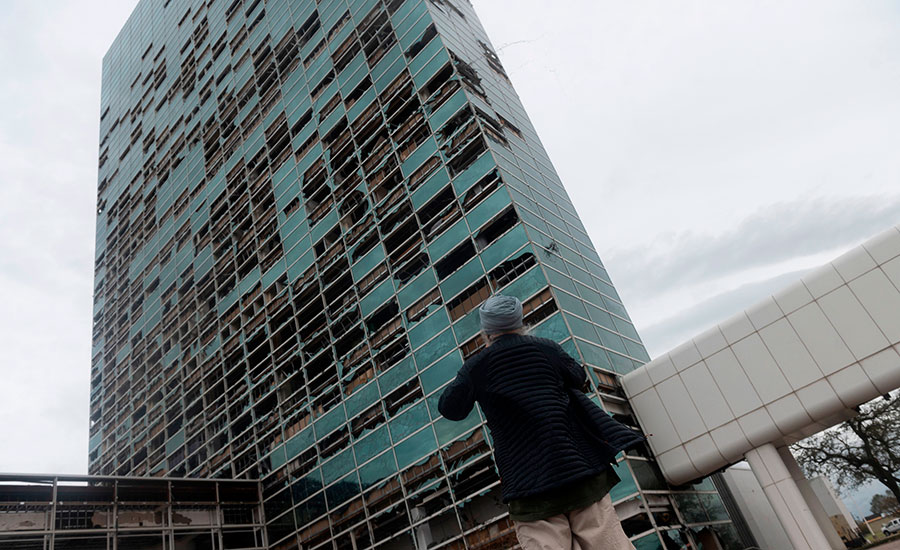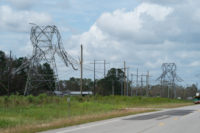Hurricane Laura “catastrophically damaged” southwest Louisiana’s electric system when it made landfall early Aug. 27 as a Category 4 hurricane, with winds up to 150 mph.
“We expect the recovery to be as difficult and challenging as we have ever faced in the past. Customers should expect extended power outages lasting weeks,” Phillip May, president and CEO of Entergy Louisiana, said in a statement.
The utility has been lauded by industry groups for its hurricane preparations and is accustomed to the blows dealt to its system by tropical storms. But Laura, which rapidly intensified over the Gulf of Mexico before hitting the state, handed the utility “some of the most severe damage the company has experienced,” the company said.
With damage assessments only half complete on Aug. 31, the utility reported it had already counted more than 220 major structures needing to be replaced or repaired, plus more than 8,000 poles and 3,000 transformers damaged in its distribution system.
As of Aug. 31, 51% of customers had been restored, while 133,550 customers had yet to be restored. Entergy expects crews will need to perform major construction and repairs over land and water to restore service across the affected areas, the company said.
“We have a long road ahead of us,” Gov. John Bel Edwards (D) of Louisiana said on Aug. 30 about the overall damage.
Damage was extensive in Lake Charles, La., 30 miles inland, where the National Weather Service recorded wind speeds as high as 128 mph. One of the most visible spots to take damage was the 310-ft-tall Capital One Tower. Originally built in the 1980s, more than half of the tower’s all-glass exterior was shattered. Hurricane Rita also caused damage in 2005, but to a much lesser extent.
Meanwhile, the city’s Calcasieu River bridge on I-10 is back open after a close call Aug. 27, when the Isle of Capri casino riverboat came loose from its moorings, struck the bridge and became wedged beneath it. The Louisiana Dept. of Transportation and Development inspected the bridge before reopening it Aug. 28.
“It wasn’t a strike that had so much force that it threatened the footings or any of the substructure. But it was a problem, and obviously it needed to be resolved. The DOTD checked it and declared it safe,” says John Basilica, Gulf Coast office leader for HNTB Corp. It was a close call for the 70-year-old bridge, which is almost two decades past its intended life span and is being surveyed for eventual replacement. DOTD officials previously said it could take until at least 2024 for construction to begin on a new bridge.
Further south, the U.S. Army Corps of Engineers has been surveying damage to seven navigation locks it operates along the Gulf Intracoastal Waterway between Lake Charles and Morgan City. Ricky Boyett, spokesman for the Corps’ New Orleans District, says the structures remain functional and that the Corps—which closes the locks when a major storm is approaching—was able to reopen all seven locks to allow for drainage. “There will be some repair work we’ll have to do,” he adds.
Boyett says the damage could have been much worse; the locks remained functional only because of storm-proofing upgrades the Corps made to the structures after hurricanes Rita in 2005 and Ike in 2008.
The refining and petrochemical industries had closely monitored the storm before landfall and were able to prepare well in advance, but as of Aug. 31, “it was still a little unclear as to the operating status of some of these facilities and the damages that they may have sustained,” says Suzanne Lemieux, operations security and emergency response manager for the American Petroleum Institute, a trade group for the oil and gas industry. “It looks like there was minimal damage to most of the facilities down in the Lake Charles/Beaumont area.”
At least one refinery reported loss of commercial power, and one pipeline had issues with storage. “By the end of the week, most assessments will have been completed and people will have plans in place for restoration if they don’t already,” Lemieux says. “Luckily we have an oversupplied market right now, so we haven’t seen any impacts from the delayed production or refining within the Gulf Coast area.”
Some refineries are already coming back online, and those that were idled before the storm remain so. Sasol’s Lake Charles facility shut down before the storm struck and remained shut as of Aug. 31 because of “widespread electrical blackouts and other damage,” according to a company statement. The facility didn’t suffer flooding damage, but high winds damaged cooling towers at Sasol’s chemicals complex.
“Contractors and Louisianans in general are very well prepared, but despite any level of preparedness, there’s nothing you can do when mother nature comes with that amount of fury,” says David Helveston, president and CEO of ABC Pelican.






Post a comment to this article
Report Abusive Comment